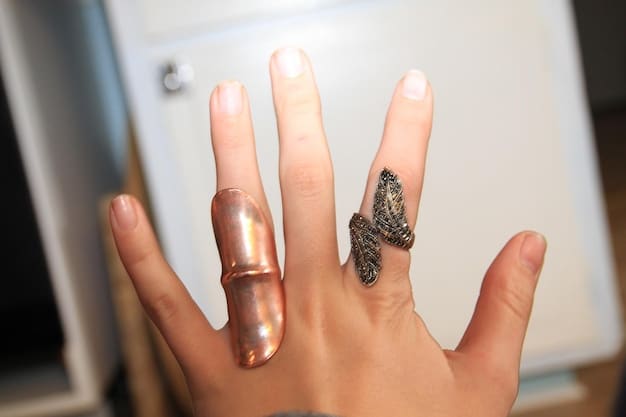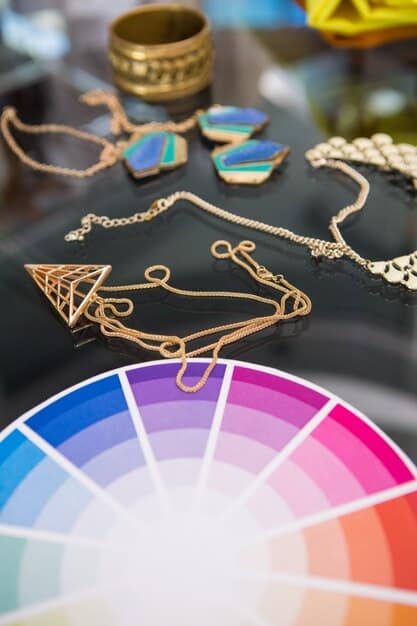The Power of Color: Flattering Clothing Colors for Your Skin Tone in the US

Advertisements
Discover how to harness the power of color to enhance your appearance by selecting clothing colors that complement your unique skin tone, ensuring a flattering and confident look.
Unlocking your best look is easier than you think, and it all starts with understanding the power of color: how to choose clothing colors that flatter your skin tone in the US. Discover the secrets to selecting the perfect hues that will brighten your complexion and boost your confidence.
Advertisements
Understand Your Skin Tone
Determining your skin tone is the crucial first step in mastering the art of color selection. Your skin tone, whether warm, cool, or neutral, influences which colors will enhance or clash with your complexion. Let’s explore how to identify your skin tone accurately.
The Undertone Test: Warm, Cool, or Neutral?
Look at the veins on your wrist under natural light. Blue or purple veins usually indicate a cool undertone, while greenish veins suggest a warm undertone. If you can’t tell or see a mix of both, you likely have a neutral undertone.
Advertisements
The Jewelry Test: Gold vs. Silver
Consider which metal complements your skin better. If gold jewelry makes your skin glow, you probably have warm undertones. If silver jewelry looks more flattering, you likely have cool undertones. Neutral skin tones can typically wear both metals equally well.

Identifying your skin tone using these tests will provide a solid foundation for choosing clothing colors that enhance your natural beauty.
Colors for Warm Skin Tones
Warm skin tones, characterized by golden or yellow undertones, shine brightest in colors that echo these hues. Embracing earth tones and vibrant shades can truly enhance a warm complexion. Let’s explore which colors work best.
Earthy Delights: Browns, Greens, and Oranges
These colors enhance the natural warmth in your skin. Think olive greens, rust oranges, and chocolate browns. These shades bring out the richness in your complexion.
Go Bold with Reds and Yellows
Warm reds, like brick or rust, and golden yellows can add vibrancy to your look. These colors complement the natural warmth in your skin, providing a healthy, radiant glow.
- Olive Green: A sophisticated choice that highlights golden undertones.
- Rust Orange: Adds warmth and vibrancy to your complexion.
- Golden Yellow: Creates a cheerful and radiant appearance.
- Chocolate Brown: A classic, versatile color that complements warmth.
Choosing these colors will ensure your wardrobe complements your warm skin tone, making you look effortlessly radiant.
Colors for Cool Skin Tones
Cool skin tones, distinguished by pink or blue undertones, are best complemented by colors that share these cooler hues. Colors like blues, purples, and silvers can enhance a cool complexion, making you look vibrant and polished. Let’s dive into which colors work best.
Blues and Purples: A Cool Palette
From deep navy to icy blues and lavender to eggplant purples, these shades bring out the coolness in your skin. These colors accentuate the cool undertones, providing a harmonious balance.

Silvers and Grays: Understated Elegance
Silver and gray add a touch of sophistication to your wardrobe. These neutral shades enhance rather than compete with your cool skin tone, offering a sleek and modern look.
- Navy Blue: A timeless color that enhances cool undertones.
- Lavender Purple: Adds a soft, romantic touch to your look.
- Icy Blue: Brings out the vibrancy in your complexion.
- Silver Gray: Offers a sleek and modern appearance.
Opting for these colors will ensure your wardrobe enhances your cool skin tone, helping you achieve a refined and balanced appearance.
Colors for Neutral Skin Tones
Neutral skin tones, having a balance of warm and cool undertones, offer a versatile canvas for virtually any color. However, certain shades can truly elevate a neutral complexion. Let’s explore the best color choices.
Soft Pinks and Peaches: A Gentle Flush
These soft, muted shades add a touch of warmth to a neutral complexion without overpowering it. They create a healthy, balanced glow.
Greys and Taupes: Effortless Sophistication
These neutral colors complement both warm and cool undertones. They offer a sophisticated look without clashing, ensuring a harmonious appearance.
For neutral skin tones, it’s all about balance. Avoid overly bright or saturated colors that can overwhelm your complexion. Instead, opt for muted, softer shades.
- Dusty Rose: Adds a subtle pop of color without being overpowering.
- Light Peach: Enhances the natural warmth in your skin.
- Soft Grey: Offers a versatile and sophisticated look.
- Taupe: Complements both warm and cool undertones.
Choosing these colors will ensure your wardrobe complements your neutral skin tone, providing a balanced and effortlessly stylish appearance.
Colors to Avoid: Considering Contrast and Undertones
While understanding which colors complement your skin tone is crucial, knowing which colors to avoid is equally important. Certain colors can clash with your undertones or create unflattering contrasts. Let’s explore the colors you might want to steer clear of.
Harsh Colors: Steer Clear of Neons
Neon colors can wash out many skin tones, making you look pale or sallow. They often create an overwhelming contrast that detracts from your natural complexion.
Colors That Clash with Undertones
If you have warm undertones, avoid icy blues and silvers. Similarly, if you have cool undertones, steer clear of mustard yellows and olive greens. These colors can make your skin look dull or uneven.
Remember, these are general guidelines. Personal preference plays a huge role, and it’s always best to experiment and see what works best for you.
- Neon Pink: Can wash out warm and neutral skin tones.
- Icy Blue: May clash with warm undertones.
- Mustard Yellow: Can dull cool undertones.
- Overly Saturated Colors: May overpower neutral skin tones.
By avoiding these colors, you can ensure your wardrobe choices consistently enhance your natural beauty, providing a polished and harmonious appearance.
Test and Experiment: Finding Your Personal Palette
The best way to determine which colors truly flatter you is through experimentation. Try different colors in various lighting conditions and observe how they affect your complexion. Let’s dive into some practical tips for testing colors.
Try Clothes On in Natural Light
Natural light provides the most accurate reflection of how a color will look on your skin. Avoid artificial lighting, which can alter colors and give misleading results.
Take Photos and Compare
Snap photos of yourself wearing different colors and compare them side by side. This can help you identify subtle differences and determine which colors make you look your best.
Don’t be afraid to step outside of your comfort zone and try something new. You might be surprised by what you discover!
- Use a Mirror: Evaluate how different colors affect your complexion.
- Seek Honest Feedback: Ask friends or family for their opinions.
- Consider Different Shades: Experiment with variations of colors within your palette.
- Mix and Match: Combine colors to see how they interact with your skin tone.
By testing and experimenting, you can curate a personal palette that enhances your natural beauty, ensuring you always look and feel your best.
| Key Point | Brief Description |
|---|---|
| 🎨 Identify Skin Tone | Determine if you have warm, cool, or neutral undertones using vein and jewelry tests. |
| 🔥 Warm Tones | Opt for earth tones like olive green, rust orange, and golden yellow. |
| ❄️ Cool Tones | Choose blues, purples, and silvers like navy blue, lavender, and icy blue. |
| ⚖️ Neutral Tones | Experiment with soft pinks, peaches, greys, and taupes for balance. |
Frequently Asked Questions
▼
Check the veins on your wrist under natural light. Blue or purple veins indicate cool undertones, while greenish veins suggest warm undertones. If you see both, you’re likely neutral.
▼
Warm skin tones should generally avoid icy blues, silvers, and overly saturated colors. These can clash and make your skin look dull or uneven.
▼
Yes, neutral colors like soft greys, taupes, and muted shades generally work well for all skin tones as they provide balance without overpowering the complexion.
▼
Considering the season can be helpful. Lighter, brighter colors often work well in spring and summer, while richer, deeper colors are great for fall and winter.
▼
Absolutely! These are just guidelines. Personal preference is key. If you love a color, wear it confidently! Experiment with different shades and accessories to make it work for you.
Conclusion
Choosing the right clothing colors can dramatically enhance your appearance and boost your confidence. By understanding your skin tone and experimenting with different shades, you can curate a wardrobe that truly complements your natural beauty. Don’t be afraid to explore and find what works best for you, making every outfit a statement of your unique style.